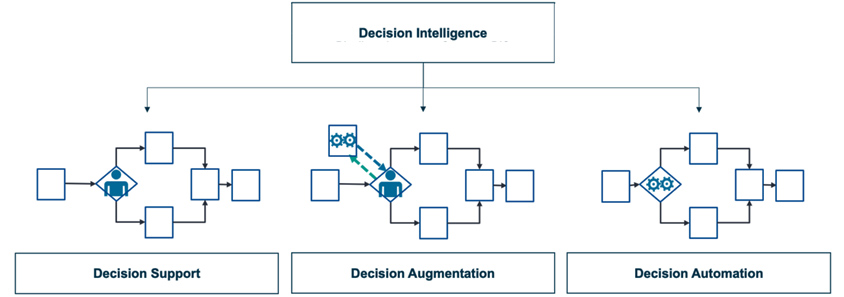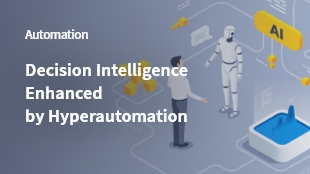The need for more accurate and swift decision-making has become increasingly critical in today's business environment, where rapid changes and uncertainties are prevalent. As a result, the importance of decision intelligence is being highlighted, and the emergence of hyperautomation is further strengthening its role.
In March 2018, Google identified decision intelligence and AI as cornerstones of its business model, marking a significant turning point in its strategic approach. By appointing Cassie Kozyrkov as the first Chief Decision Scientist, Google aimed to increase the understanding and use of decision intelligence across the organization. One of the primary roles of the Chief Decision Scientist was to educate all employees on decision intelligence. This was a major step forward for the term “decision intelligence” to begin to attract attention to the world in earnest. And then in 2019, decision intelligence gained wider public recognition through Dr. Lorien Pratt's book, "Link: How Decision Intelligence Connects Data, Actions, and Outcomes for a Better World."
In October 2021, Gartner named decision intelligence as a "strategic technology trend for 2022." According to Gartner, decision intelligence is defined as a broad decision-making technology domain that integrates multiple traditional and advanced fields to design, model, align, execute, monitor, and adjust decision models and processes. Its importance has continued to grow, as it was also selected as a strategic technology trend for 2024.
Decision intelligence is a data-driven process that enables faster and more accurate decision-making based on facts rather than relying on intuition or instinct. The goal of decision intelligence is to ensure that decisions made by humans (to make better decisions) get the desired outcome when building AI models. That's why decision intelligence is all about designing and executing decision models that comprehensively leverage AI, ML, and automation technologies. This creates business value and enables the implementation of actionable measures by generating immediate business recommendations. This approach is revolutionizing data-driven decision-making.
Decision intelligence connects data to decisions, actions, and outcomes. It generates insights from data, makes decisions using them, executes those decisions, and supports the feedback process by measuring effectiveness and performance.
Decision models driven by decision intelligence can be divided into decision support, decision augmentation, and decision automation.

- Decision Support
- Decision Augmentation(의사결정 증강)
- Decision Automation
Decision support uses AI technology to assist human decision-makers by collecting and analyzing evidence, recognizing and diagnosing problems, suggesting possible courses of action, and evaluating proposed actions. It can provide business users with comprehensive data visualization through dashboards and sophisticated business intelligence tools. Users then use the insights to make informed decisions based on the latest data.
Decision augmentation uses analyzed data to recommend decisions and predict future outcomes. By combining technology and analytics with specific business processes, machines are enabled to merge data, identify patterns, and provide recommendations. The recommendations are delivered to decision-makers through various user interfaces (email, text messages, voice, etc.). These tasks can be created user-defined (if, then, else), analytics-driven (complex pricing models), or AI and machine learning-based. Rather than merely providing information, decision augmentation enriches insights by integrating AI and advanced analytics, uncovering hidden insights from massive datasets that may be difficult or impossible for business users to process on their own.
Decision automation autonomously carries out decision-making processes and execution based on AI, analytics, and business rules. It means that decisions within a process are made using business rules and data without human intervention. This automation is moving toward the era of hyperautomation and expanding the realm of decision intelligence. Operating within a secure framework, it is expected to make strategic decisions based on AI, analytics, and business rules.
Hyperautomation is ushering in a new era for decision intelligence. It is expected to bring innovative changes to all processes, from data acquisition and analysis to decision-making, helping businesses operate smarter and stay ahead of the competition. In the future business environment, hyperautomation and decision intelligence will be closely integrated, driving the continuous advancement of businesses.
▶ This content is protected by the Copyright Act and is owned by the author or creator.
▶ Secondary processing and commercial use of the content without the author/creator's permission is prohibited.
- #Hyperautomation
- #DecisionIntelligence
- #DecisionSupport
- #DecisionAugmentation
- #DecisionAutomation
- #DataDrivenDecisionMaking
- #DDDM
- #Automation
- #AI

Strategic Marketing Office, Samsung SDS
Corporate Strategy & Business Development, and Customer Success Lead
